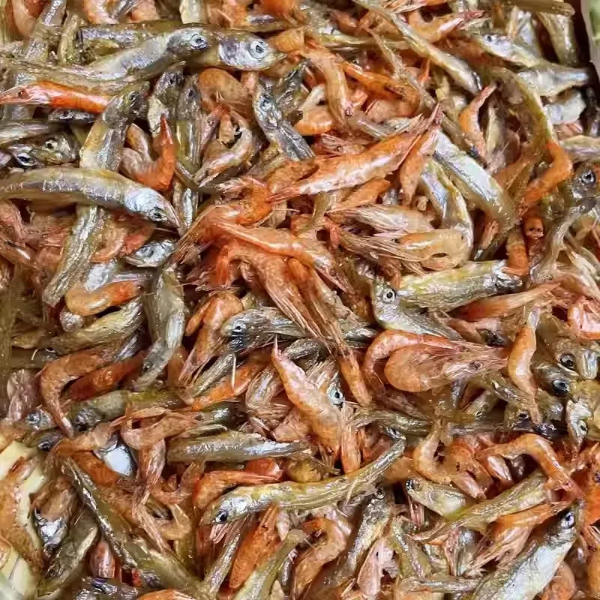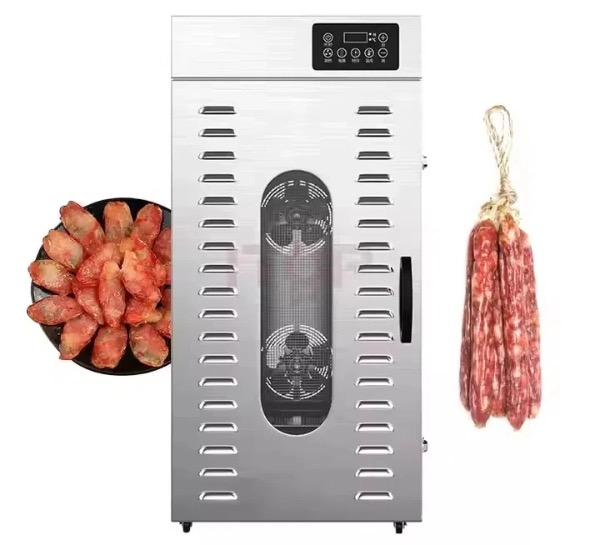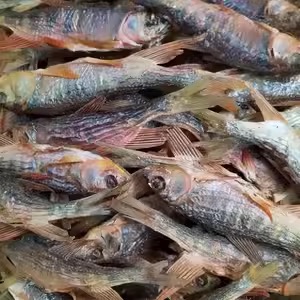Introduction
In the food processing industry, particularly in seafood processing, the drying method plays a crucial role in preserving product quality and extending shelf life. Hang type dryers have emerged as a popular choice due to their efficiency and effectiveness in removing moisture from various food items. This article explores the benefits of hang type dryers specifically for seafood processing, discusses best practices for their use, and addresses frequently asked questions (FAQs) regarding their operation and maintenance.

Understanding Hang Type Dryers
Hang type dryers utilize a vertical arrangement where food products are suspended on hangers within a controlled drying chamber. This design maximizes airflow around the products, ensuring even drying and minimizing the risk of damage. The core components of these machines include:
1. Hangers: Typically made from food-grade stainless steel to ensure hygiene and durability.
2. Enclosed Chamber: Provides a controlled environment that optimizes temperature and humidity levels.
3. Air Circulation System: Ensures uniform airflow throughout the chamber, preventing dead zones where moisture can accumulate.
4. Heating Elements: Electric resistance heaters or infrared heaters provide controlled heat for effective drying.
5. Control Panel: Allows users to set specific drying parameters tailored to different seafood products.
Benefits of Hang Type Dryers for Seafood Processing
1. Gentle Drying Process
The hanging method minimizes bruising and damage to delicate seafood products. This is particularly important for items like fish fillets or shrimp, which can easily be crushed or misshapen during drying. The even distribution of weight across the hanger prevents concentrated pressure points that could compromise the product's integrity. Additionally, the absence of direct contact with drying surfaces further reduces the risk of physical damage.
2. Preservation of Nutritional Value
Hang type dryers allow for precise control over temperature and humidity, helping to retain essential vitamins and minerals that might be lost in traditional drying methods. Low-temperature drying is especially beneficial for preserving heat-sensitive nutrients. For example, omega-3 fatty acids, which are prevalent in many types of fish, are prone to degradation at higher temperatures. By using controlled, low-heat drying, these vital nutrients can be effectively preserved, enhancing the nutritional value of the final product.
3. Energy Efficiency
These machines often incorporate advanced technologies that reduce energy consumption while maintaining optimal drying conditions. For instance, heat pump technology can save up to 75% of energy compared to conventional methods, making them a more sustainable option. Heat recovery systems capture and reuse waste heat, further enhancing energy efficiency. Programmable logic controllers (PLCs) precisely manage the operation of the dryer, optimizing energy usage based on real-time conditions and product requirements.
4. Versatility
Hang type dryers are suitable for a wide range of seafood products, including fish, shellfish, and seaweed. This versatility makes them an invaluable investment for food processing companies handling various seafood items. From delicate fish fillets to sturdy shellfish, the adjustable settings and controlled environment accommodate different drying needs. For example, seaweed may require lower temperatures and longer drying times compared to fish fillets to achieve the desired moisture content without scorching or over-drying.
5. Space-Saving Design
The vertical arrangement of hang type dryers optimizes floor space in production facilities, which is particularly beneficial for companies with limited room. This is especially useful in urban areas or facilities where space is at a premium. By utilizing vertical space, processing companies can maximize their production capacity without the need for costly expansions.

Best Practices for Using Hang Type Dryers
To maximize the efficiency and effectiveness of hang type dryers in seafood processing, consider the following best practices:
1. Pre-treatment of Seafood
Before placing seafood in the dryer, it is advisable to pre-treat it by rinsing and removing excess moisture. This can enhance the overall drying process and improve product quality. Pre-treatment might include soaking the seafood in a brine solution to enhance flavor and preservation or applying a light coating to prevent oxidation. Proper pre-treatment reduces the drying time and minimizes the risk of spoilage during the drying process.
2. Optimal Loading Techniques
Ensure that seafood is evenly spaced on hangers to allow adequate airflow around each piece. Overloading can lead to uneven drying and compromise product quality. Proper spacing between items ensures uniform exposure to the drying air, preventing moisture buildup in certain areas. Load distribution should also be balanced to maintain the dryer's stability and prevent mechanical stress on the hangers and support structure.
3. Regular Maintenance
Routine maintenance of the dryer is essential for optimal performance. This includes cleaning air filters, checking heating elements, and ensuring that fans are functioning correctly. Regular inspections should include checking for leaks, inspecting the integrity of the insulation, and lubricating moving parts to prevent wear and tear. A well-maintained dryer operates more efficiently, prolongs its lifespan, and reduces the risk of unexpected breakdowns.
4. Monitoring Temperature and Humidity
Utilize the control panel to monitor temperature and humidity levels during the drying process closely. Adjust settings as needed based on the specific requirements of the seafood being processed. Modern control panels offer advanced features such as real-time data logging, remote monitoring, and automated adjustments based on pre-programmed drying profiles. Monitoring and adjusting these parameters ensures consistent product quality and prevents over-drying or under-drying.
5. Post-drying Handling
After drying, handle seafood carefully to avoid damage. Proper packaging should be utilized to maintain product quality during storage and transportation. Consider using vacuum sealing or modified atmosphere packaging (MAP) to extend the shelf life of the dried seafood. The packaging material should be food-grade and provide a barrier against moisture, oxygen, and light to prevent spoilage and maintain flavor.
Advanced Technologies in Hang Type Dryers
1. Heat Pump Technology
Heat pump dryers use a refrigeration cycle to remove moisture from the air. They are significantly more energy-efficient than traditional electric resistance dryers, reducing energy consumption by up to 75%.
2. Programmable Logic Controllers (PLCs)
PLCs allow for precise control over the drying process, optimizing temperature, humidity, and airflow. These advanced controllers can be programmed with specific drying profiles for different seafood products, ensuring consistent quality.
3. Remote Monitoring and Control
Modern hang type dryers can be equipped with remote monitoring and control capabilities, allowing operators to monitor and adjust drying parameters from anywhere with an internet connection.
4. Integrated Cleaning Systems
Some dryers feature integrated cleaning systems that automatically clean the drying chamber and hangers, reducing the risk of contamination and ensuring hygiene.
5. Data Logging and Analysis
Advanced data logging systems record temperature, humidity, and other critical parameters throughout the drying process. This data can be analyzed to optimize drying profiles and improve product quality.
Specific Applications in Seafood Processing
1. Drying Fish Fillets
Hang type dryers are ideal for drying fish fillets, such as cod, salmon, and tuna. The gentle drying process preserves the texture and flavor of the fish.
2. Processing Shrimp and Shellfish
These dryers are also suitable for drying shrimp, scallops, and other shellfish. The precise temperature control prevents overcooking and ensures a consistent product.
3. Drying Seaweed
Hang type dryers can be used to dry seaweed for use in sushi, soups, and other culinary applications. The low-temperature drying preserves the nutrients and flavor of the seaweed.
4. Producing Jerky and Dried Snacks
The controlled environment of hang type dryers makes them ideal for producing seafood jerky and other dried snacks. The uniform airflow ensures even drying and prevents spoilage.
Factors to Consider When Selecting a Hang Type Dryer
1. Capacity
Choose a dryer with sufficient capacity to meet your production needs. Consider the volume of seafood you need to process daily and the available space in your facility.
2. Energy Efficiency
Opt for a dryer with high energy efficiency to reduce operating costs and minimize your environmental impact.
3. Control System
Select a dryer with a user-friendly control system that allows for precise adjustment of temperature, humidity, and airflow.
4. Construction Materials
Ensure that the dryer is constructed from food-grade stainless steel and other durable materials to ensure hygiene and longevity.
5. Maintenance Requirements
Consider the maintenance requirements of the dryer and choose a model that is easy to clean and maintain.
Conclusion
Hang type dryers offer significant advantages for seafood processing by providing efficient, gentle drying while preserving nutritional value and product quality. The advanced technologies integrated into modern dryers, such as heat pumps and PLCs, enhance energy efficiency and control. By following best practices in their operation, food processors can optimize their use of these machines to achieve superior results and meet the growing demand for high-quality dried seafood products. As the seafood industry continues to evolve, hang type dryers will remain a critical tool for processors looking to improve their efficiency, reduce waste, and deliver superior products to consumers.

FAQs
1. What types of seafood can be dried using hang type dryers?
Hang type dryers are versatile and can be used for various seafood products including fish fillets, shrimp, shellfish, and seaweed. The key is to adjust the drying parameters according to the specific needs of each type of seafood to ensure optimal results.
2. How do I maintain a hang type dryer?
Regular maintenance includes cleaning air filters, checking heating elements, ensuring fans are operational, and monitoring temperature settings. Additionally, inspect the hangers for any signs of wear or corrosion and replace them as needed. A preventive maintenance schedule can help identify potential issues before they become major problems.
3. Can hang type dryers save energy?
Yes, many hang type dryers incorporate energy-efficient technologies such as heat pumps that significantly reduce energy consumption compared to traditional methods. Look for models with energy-saving features like variable frequency drives for the fans and insulated panels to minimize heat loss.
4. What is the ideal temperature for drying seafood?
The ideal temperature varies depending on the type of seafood but generally ranges from 40°C to 60°C (104°F to 140°F) for effective moisture removal without compromising quality. Delicate items like seaweed may require lower temperatures, while thicker cuts of fish can tolerate slightly higher temperatures.
5. How long does the drying process take?
Drying times depend on several factors including the type of seafood, thickness of pieces, humidity levels in the dryer, and specific machine settings but typically range from several hours to a full day. Monitoring the moisture content of the seafood throughout the drying process is essential to determine the optimal drying time.
Citations:
[1] https://www.dryeratech.com/exploring-the-technology-behind-hang-type-drying-machines.html
[2] https://patents.google.com/patent/CN110207480A/zh
[3] https://www.dryeratech.com/the-impact-of-hang-type-dryers-on-product-quality-and-safety.html
[4] https://patents.google.com/patent/CN109252340A/zh
[5] https://www.researchgate.net/publication/277701875_Drying_of_Fish
[6] https://patents.google.com/patent/CN1405396A/zh
[7] https://www.mdpi.com/2227-9717/12/5/942
[8] https://patents.google.com/patent/WO2017197612A1/zh











